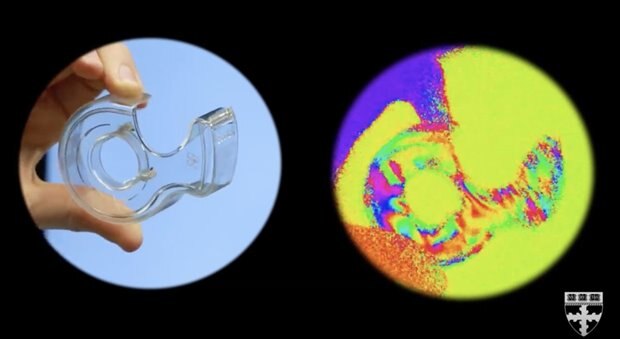Researchers at the Harvard John A. Paulson School of Engineering and Applied Sciences (SEAS) have come up with a way to image polarization out of one snapshot. The tiny, portable camera is the same size as a thumb and can be used in systems of autonomous vehicles, aircraft or even satellites to observe chemistry in the atmosphere, or even be used to detect objects that blend into the background. The team presented their findings in Science.
The polarization camera gives us a glimpse of normal vision on the left and what vision is like to an insect or shrimp, on the right. (Image Credit: Harvard)
“This research is game-changing for imaging,” said Federico Capasso, the Robert L. Wallace Professor of Applied Physics and Vinton Hayes Senior Research Fellow in Electrical Engineering at SEAS and senior author of the paper. “Most cameras can typically only detect the intensity and color of light but can’t see polarization. This camera is a new eye on reality, allowing us to reveal how light is reflected and transmitted by the world around us.”
“Polarization is a feature of light that is changed upon reflection off a surface,” said Paul Chevalier, a postdoctoral fellow at SEAS and co-author of the study. “Based on that change, polarization can help us in the 3D reconstruction of an object, to estimate its depth, texture and shape, and to distinguish man-made objects from natural ones, even if they’re the same shape and color.”
In order to unleash the full power of polarization, the team took advantage of harnessing metasurfaces, which are defined as nanoscale structures that merge with light at wavelength size-scales. “If we want to measure the light’s full polarization state, we need to take several pictures along different polarization directions,” said Noah Rubin, first author of the paper and graduate student in the Capasso Lab. “Previous devices either used moving parts or sent light along multiple paths to acquire the multiple images, resulting in bulky optics. A newer strategy uses specially patterned camera pixels, but this approach does not measure the full polarization state and requires a non-standard imaging sensor. In this work, we were able to take all of the optics needed and integrate them in a single, simple device with a metasurface.”
The polarization camera uses an array of nanopillars to beam light on an object, creating the polarization effect. (Image Credit: Harvard)
By using a new technique on how polarized light interacts with materials, researchers were able to build a metasurface that uses an array of organized subwavelength spaced nanopillars to beam light due to its polarization. Afterward, the light creates four images that show how conditions differ to the polarization. When the images are taken at the same time, a full snapshot of polarization at each pixel can be observed. The special camera is only two centimeters long and has the same level of complexity as a smartphone camera. It contains an attached lens and a protective case. When testing the camera, researchers used it to view deformities in injection-molded plastic objects, used it outdoors to capture the polarization off car windshields and took facial snapshots to show how the camera can picture the 3D curves of a human face.
“This technology could be integrated into existing imaging systems, such as the one in your cell phone or car, enabling the widespread adoption of polarization imaging and new applications previously unforeseen,” said Rubin.
“This research opens an exciting new direction for camera technology with unprecedented compactness, allowing us to envision applications in atmospheric science, remote sensing, facial recognition, machine vision and more,” said Capasso.
Have a story tip? Message me at: cabe(at)element14(dot)com
http://twitter.com/Cabe_Atwell



-

dubbie
-
Cancel
-
Vote Up
0
Vote Down
-
-
Sign in to reply
-
More
-
Cancel
Comment-

dubbie
-
Cancel
-
Vote Up
0
Vote Down
-
-
Sign in to reply
-
More
-
Cancel
Children